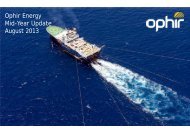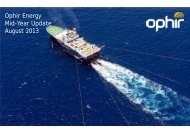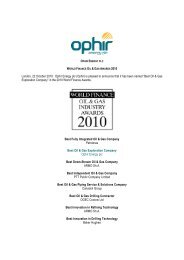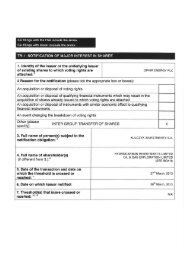Ophir Energy plc Annual Report and Accounts 2011
Ophir Energy plc Annual Report and Accounts 2011
Ophir Energy plc Annual Report and Accounts 2011
You also want an ePaper? Increase the reach of your titles
YUMPU automatically turns print PDFs into web optimized ePapers that Google loves.
67<br />
<strong>Ophir</strong> <strong>Energy</strong> <strong>plc</strong> <strong>Annual</strong> <strong>Report</strong> <strong>2011</strong><br />
2 Basis of preparation <strong>and</strong> significant accounting policies continued<br />
2.9 Inventories<br />
Inventories which comprise drilling consumables are stated at the lower of cost <strong>and</strong> net realisable value. Cost is<br />
determined by using weighted average cost method <strong>and</strong> comprises direct purchase costs, cost of transportation<br />
<strong>and</strong> other related expenses.<br />
2.10 Cash <strong>and</strong> short-term deposits<br />
Cash <strong>and</strong> short-term deposits in the balance sheet comprise cash at bank, in h<strong>and</strong> <strong>and</strong> short-term deposits with<br />
original maturity dates of up to 12 months.<br />
2.11 Trade <strong>and</strong> other payables<br />
Trade <strong>and</strong> other payables are carried at amortised cost. They represent liabilities for goods <strong>and</strong> services provided<br />
to the Group prior to the end of the financial year that are unpaid <strong>and</strong> arise when the Group becomes obligated to<br />
make future payments in respect of the purchase of those goods <strong>and</strong> services. The amounts are unsecured <strong>and</strong><br />
are usually paid within 30 days of recognition.<br />
2.12 Provisions<br />
A provision is recognised when the Group has a legal or constructive obligation as a result of a past event <strong>and</strong> it is<br />
probable that an outflow of economic benefits will be required to settle the obligation <strong>and</strong> a reliable estimate can<br />
be made of the obligation. If the effect of the time value of money is material, expected future cash flows are<br />
discounted using a current pre-tax rate that reflects, where appropriate, the risks specific to the liability. Where<br />
discounting is used, the increase in the provision due to unwinding the discount is recognised as a finance cost.<br />
2.13 Pensions <strong>and</strong> other post-retirement benefits<br />
The Group does not operate its own pension plan but makes pension or superannuation contributions to private<br />
funds of its employees which are defined contribution plans. The cost of providing such benefits are expensed in<br />
the income statement as incurred.<br />
2.14 Employee benefits<br />
Wages, salaries, annual leave <strong>and</strong> sick leave<br />
Liabilities for wages <strong>and</strong> salaries, including non-monetary benefits, annual leave <strong>and</strong> accumulating sick leave<br />
expected to be settled within 12 months of the reporting date are recognised in respect of employees’ services<br />
up to the reporting date. They are measured at the amounts expected to be paid when the liabilities are settled.<br />
Liabilities for non-accumulating sick leave are recognised when the leave is taken <strong>and</strong> are measured at the rates<br />
paid or payable.<br />
Long service leave<br />
The liability for long service leave is recognised <strong>and</strong> measured at the present value of expected future payments<br />
to be made in respect of services provided by employees up to the reporting date using the projected unit credit<br />
method.<br />
BUSINESS REVIEW GOVERNANCE FINANCIAL STATEMENTS<br />
Consideration is given to expected future wage <strong>and</strong> salary levels, experience of employee departures <strong>and</strong> periods<br />
of service. Expected future payments are discounted using market yields at the reporting date on national<br />
government bonds with terms to maturity <strong>and</strong> currencies that match, as closely as possible, the estimated future<br />
cash outflows.<br />
2.15 Equity instruments<br />
Equity instruments issued by the Company are recorded at the proceeds received, net of direct issue costs.<br />
2.16 Interest-bearing borrowing<br />
All loans <strong>and</strong> borrowings are initially recognised at fair value less directly attributable transaction costs.<br />
After initial recognition, interest-bearing loans <strong>and</strong> borrowings are subsequently measured at amortised cost<br />
using the effective interest rate method.<br />
Gains <strong>and</strong> losses are recognised in the income statement when liabilities are derecognised as well as through the<br />
amortisation process. A financial liability is derecognised when the obligation under the liability is discharged or<br />
cancelled or expires.








